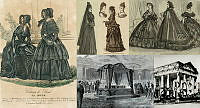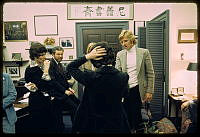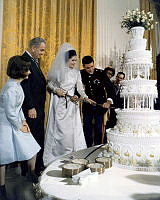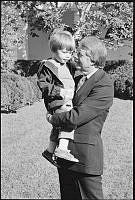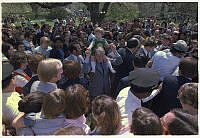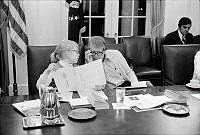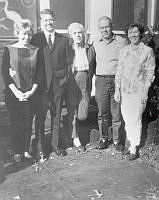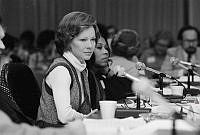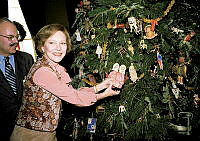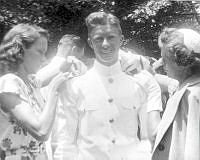Lucretia Garfield
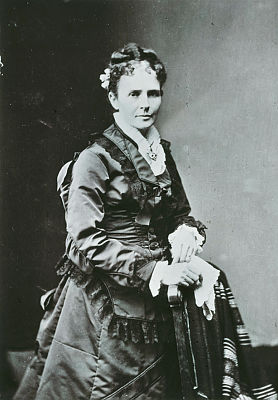
Lucretia “Crete” Rudolph was born to parents Zeb and Arabella Rudolph in Garrettsville, Ohio, on April 19, 1832.1 Crete excelled academically from a young age, attending Geauga Seminary, followed by Western Reserve Eclectic Institute (now Hiram College) to further her studies. After commencement, she worked as a teacher in Ohio.2
On November 11, 1858, Lucretia married her former classmate, James A. Garfield, and together, they had seven children: Eliza Arabella, Harry, James, Mollie, Irvin, Abram, and Edward.3 Eliza Arabella, known as “Little Trot” and Edward, known as “Neddie,” did not live to adulthood.
As James Garfield pursued a political career, Lucretia managed the household and raised their children. She also advised her husband, talking through political matters with him and sometimes assisting with his speeches.4 Upon his Inauguration on March 4, 1881, the Garfield family moved into the White House and Lucretia took on the official duties of a first lady, hosting White House dinners and receptions as well as attending events elsewhere. She also lifted the ban on alcohol at the White House, instituted by her predecessor, Lucy Hayes.5
Mrs. Garfield had ambitious plans to restore and redecorate the White House.6 However, her plans were derailed when she contracted malaria in May 1881.7 She traveled to the Long Branch, New Jersey, seaside to recover —but while there, she received shocking news. On July 2, assassin Charles Guiteau shot and seriously injured President Garfield.8 She quickly returned to the White House to care for her husband, who never recovered. They later took him to Long Branch, hoping that the sea air would improve his condition; President Garfield died there on September 19, 1881.
After his death, Lucretia and her children returned to Ohio in mourning. Out of the public eye, the former first lady looked after her children and protected her husband’s legacy, preserving his papers and overseeing the creation of a memorial in his honor.9 In addition to a pension from Congress, citizens across the country donated toward a fund for the Garfield family, allowing Lucretia and her children to live in comfort for years to come.10
In the later years of her life, Lucretia Garfield was the steadfast matriarch of her large family. She continued her lifelong interest in academic pursuits including literary clubs, attended the theater, and supported charitable causes like the Red Cross.11 Ultimately, she outlived her husband by thirty-seven years. Mrs. Garfield passed away on March 13, 1918, and is entombed next to her husband at the James A. Garfield Memorial in Cleveland, Ohio.
Footnotes & Resources
- “Lucretia R. Garfield: A Remarkable Life,” National Park Service, https://www.nps.gov/people/lucretia-r-garfield-a-remarkable-life.htm.
- Ibid.
- “Meet the Children of President and Mrs. Garfield,” James A. Garfield National Historic Site, National Park Service, https://www.nps.gov/jaga/meet-the-children-of-president-and-mrs-garfield.htm.
- “Lucretia R. Garfield: A Remarkable Life Part 2,” National Park Service,
https://www.nps.gov/articles/000/lucretia-r-garfield-a-remarkable-life-part-2.htm. - “First Lady Biography: Lucretia Garfield,” National First Ladies Library, http://archive.firstladies.org/biographies/firstladies.aspx?biography=21.
- William Seale, The President’s House Volume 1 (Washington D.C.: White House Historical Association, 2008), 497-498.
- “Malaria: The Evil Spirit of the White House,” James A. Garfield National Historic Site, National Park Service, https://www.nps.gov/articles/000/malaria-the-evil-spirit-of-the-white-house.htm.
- “James A. Garfield Funeral,” White House Historical Association, https://www.whitehousehistory.org/james-a-garfield-funeral.
- “Lucretia R. Garfield: A Remarkable Life Part 2,” National Park Service,
https://www.nps.gov/articles/000/lucretia-r-garfield-a-remarkable-life-part-2.htm. - ”GoFundMe account set up for the Garfield family in 1881,” James A. Garfield National Historic Site, National Park Service, https://www.nps.gov/articles/000/gofundme-account-set-up-for-the-garfield-family-in-1881.htm.
- “Lucretia R. Garfield: A Remarkable Life Part 2,” National Park Service,
https://www.nps.gov/articles/000/lucretia-r-garfield-a-remarkable-life-part-2.htm.













